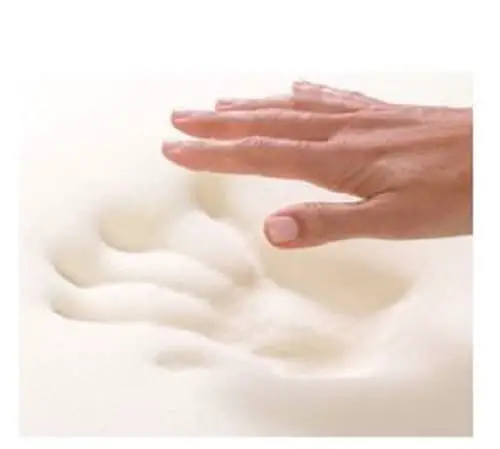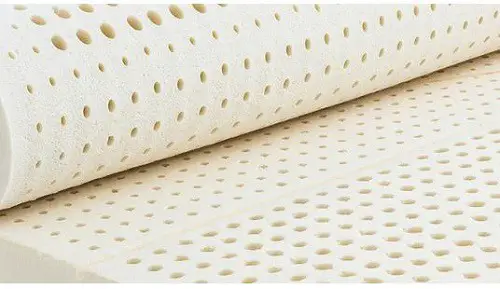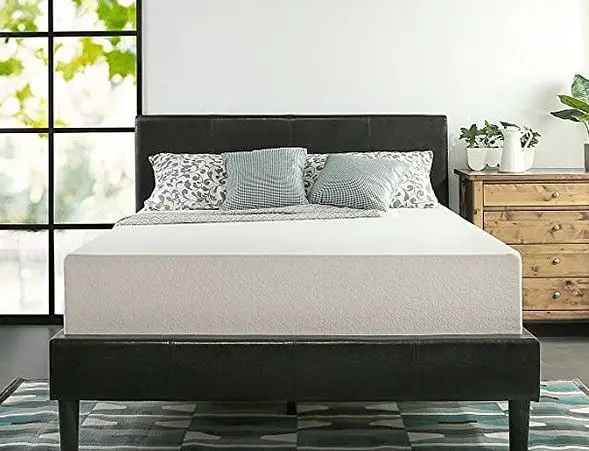Are you tired of reading about the latest latex or memory foam product – and why it’s better than everything that's come before it?
Mattress sales people and manufacturers just love to use acronyms and cool technical-sounding brand names to describe their memory foam and latex foam.
They do this to differentiate their products and to point out their individual advantages.
But it can be incredibly confusing – even for us – and we review mattresses for a living.
It’s high time to shed light on these myths and misconceptions.
The truth is that the main differences between memory foam and latex foam mattresses are significant – but really simple.
Also, most of the cool new names don’t matter nearly as much to you as these few significant differences.
In this brief guide, we’ll dive into the heart of the few main differences between Latex vs Memory Foam mattresses so you can select the right kind for your needs and budget.
What is Memory Foam?

Memory foam is a type of polyurethane foam made with various chemicals that make the foam exceedingly compact and super-energy absorbing.
When sleeping on memory foam, you will notice there's a noticeably slow recovery period. Meaning, when you press your body deep to the material and release it, the mattress will take some time to resume its original form.
This simple fact makes memory foam extremely comfortable and supportive when it is used in the upper layers.
Decades ago, NASA and mattress manufacturers recognized that this incredible characteristic of this stuff could help individuals who suffer from joint or back pain, especially.
Today, most top mattress manufacturers utilize some form of memory foam in their products.
What is Latex Foam?

In comparison to memory foam, latex foam has rapid recovery time and therefore provides far more bounce.
If you press your hands into a bed made out of latex and then lift up your hand, the mattress will regain its original shape very quickly.
There are a couple of different kinds of latex which are used for mattresses.
The first is natural latex. This comes from rubber trees and is the purest type. Natural latex can be made efficiently and is the perfect choice for somebody who wants an all-natural alternative.
Another choice is synthetic latex. This type uses a different type of rubber that's made using a variety of synthetic materials.
The most critical difference between pure latex and synthetic latex is that the artificial version will have less bounce and feels a bit more similar to memory foam.
Furthermore, there are two other subcategories of latex mattresses. We'll briefly discuss both of these types and their related benefits.
Talalay Latex vs. Dunlop Latex
The principal difference between these very popular types of latex is that Talalay is lighter because it incorporates more air. It is less supportive, however.
Conversely, Dunlop latex is famous for being denser, so it provides more support.
All in all, the Talalay is preferred by most people for a few reasons.
First off, cost: a lighter mattress costs less to ship and makes moving it easier.
Second, Talalay holds more air so it will stay cooler throughout the night. This is great for anyone who cannot stand to sleep in a hotbed.
One of the key reasons people choose Dunlop is that, over time, it tends to maintain its shape and last a long time. Due to its density, beds which employ Dunlop are inclined to prevent sagging, too.
What are the specific differences between latex and memory foam?

The most significant similarities shared between these options is that they provide posture support. They conform in some way into the shape of the body, pressure relief is supplied into the spine, neck, and joints.
Aside from that, latex and memory foam are very different regarding how much they conform to your body, movement transfer, and energy absorption.
Body Conformity
The biggest difference between latex and memory foam mattresses is the way they fit your body shape.
Memory foam conforms to the specific contour of each person far better than latex. The latex option will compress then rebound and will only adapt to the overall impressions your body makes.
Which of these options you prefer depends upon your personal taste and your sleep requirements.
Motion Transfer
Another significant difference between memory foam and latex mattresses is their ability to isolate movement.
Memory foam doesn't allow much transfer of energy from one point in the bed to another. So, if your spouse is sleeping on the opposite side of the mattress and often moves around during the night, you will hardly feel it, if at all. This is the reason couples often favor memory foam mattresses.
Latex, on the other hand, doesn't isolate movement nearly as well. During the night, in precisely the identical situation you will feel your spouse tossing and turning through the night because latex has a fast response time and is bouncy.
How to Select The Foam That's Right For You

When you are trying to choose between memory foam and a latex mattress, it all depends on what benefits you want with the mattress.
Both serve a function and are a fantastic fit for certain sorts of sleepers.
Why Select Memory Foam?
Memory foam is an excellent solution for many sleepers for many reasons.
We have outlined a few to provide you with a firm knowledge of the numerous benefits associated with this mattress choice.
1. Back Sleepers Like Memory Foam
The first reason to select this stuff over any other is if you're a back sleeper. If you're sleeping on your back, then it's vital that you opt for the mattress that will supply you sufficient neck and spinal bone alignment.
Foam contours to the particular shape of your body, it's excellent for letting your neck and spine to achieve a comfortable and healthy amount of optimal alignment.
2. Side Sleepers Like Memory Foam
If you are a side sleeper, a memory foam mattress is perfect for you. Like all sleepers, the ultimate objective is to be sure your spine is aligned correctly to prevent neck or joint discomfort when you awaken. For side sleepers, additionally, it is vital to focus on the comfort of your hip joints.
Memory foam provides the exceptional advantage of both, aligning the spine and neck throughout your sleep, and providing comfort and support for the shoulder and hip bones that press in the bed through the night.
3. Most People Prefer Memory Foam
We've now discussed back and side sleepers, but the reality is that all sleepers like the comfortability that includes sleeping on a mattress which can take on the shape of the specific body type. That is no surprise.
4. Excellent Pressure Point Relief
For people unable to get out of bed or for people who are ill in a hospital, memory foam is ideal to alleviate the pains of being unable to get up.
Patients frequently experience this when they cannot get out of bed, the lack of flow to the skin tissues and friction and gravity that's always being harmful to the body is going to take a toll and be quite painful.
Painful areas of the skin pressed against the mattress are known as a bed sore or a pressure ulcer. Bedding made from memory foam has the exceptional ability to lighten the pressure on these painful sores due to its capability to contour perfectly to the shape of the body.
5. Great for Allergy Sufferers
Memory foam is also known as one of the most hypoallergenic options in the marketplace.
For anyone who suffers from cloth allergies, such as wool or some other fibers, this is an outstanding option for you.
Since most memory foam mattresses are thick, it's far less probable that dust mites will flourish, and the material is less liable to attract dirt or germs.
Why Say “No” to Memory Foam?

Among the few reasons you would not want a memory foam mattress is that this alternative is proven to retain body heat.
If you need a cool bed to sleep well, then this may not be the best mattress for you. While manufacturers are consistently trying to alleviate this problem, it is unclear as of yet, whether they have succeeded in developing a cooling foam choice.
It is important to remember that most memory foam mattresses don't support your body enough to maintain your spine properly when you are sleeping on your back.
Finally, memory foam mattresses are famous for emitting a strange odor when you first open it up and take it from the box. These gases can be harmful, particularly for children that are exposed. Therefore, it's better to let your mattress air out for a couple of days before sleeping on it.
Or if you're concerned about the gas exposure, then pick a more conventional sort of bedding.
Why Select Latex?

There are lots of reasons why latex may be right for you.
1. Great for the environment
One big reason to choose latex foam is that latex is the best choice for the environment.
As previously discussed, natural latex comes from rubber trees, as opposed to using artificially produced petrochemicals.
It's important to remember that not all latex mattresses are organic. Artificial latex has many materials used to modify the overall feel of the bed. If you're interested in being environmentally friendly, make sure you know the materials in your bedding in addition to other chemicals used to make it.
2. Firmer and more supportive
There are different levels of comfort available in latex beds, and in general you can get any firmness you want. However, generally speaking, latex beds are famous for being firmer compared to more conventional kinds of mattresses.
When picking a latex bed, be sure to ask about available firmness choices. Many use different layering systems also that adds to the feel.
3. Latex sleeps cooler
If you're a person who needs a cooler mattress, latex is an excellent option for you. If you have never noticed the design of the latex mattress, you would be surprised to discover that almost all latex mattresses have holes punched in their foam layers. These holes allow air to flow through them, which provides a path for heat to escape the bed.
Unlike memory foam, latex mattresses sleep cooler during the night. The punch holes also make them more resistant to mold and bacteria over time.
Why Say “No” to Latex?

There are 3 reasons why a latex mattress may not be suitable for you, as follows:
The first reason is they are relatively expensive.
However, because of durability and longevity, you might discover that you won't need to get a new mattress for decades – so this might end up being affordable after all.
The second reason is that latex mattresses are famous for producing a terrible smell, especially when you open them for the first time. While this does have a tendency to go away over time, the smell can last a few weeks.
The third reason is that some individuals are allergic to latex. In reality, very few people are allergic to latex. However, it's still important to point out. If you or your spouse are allergic, then you must find another appropriate option.
Affiliate Disclosure
Affiliate Disclosure: I may earn a small commission (at no cost to you) if you purchase a mattress after clicking a referral link or using a coupon code on this site. That said, all content and opinions on this site are my own and are NOT affected by these payments.
This site participates in the Amazon Services LLC Associates Program, an affiliate advertising program designed to provide a means for sites to earn advertising fees by advertising and linking to Amazon.com.
*Amazon and the Amazon logo are trademarks of Amazon.com, Inc, or its affiliates.

